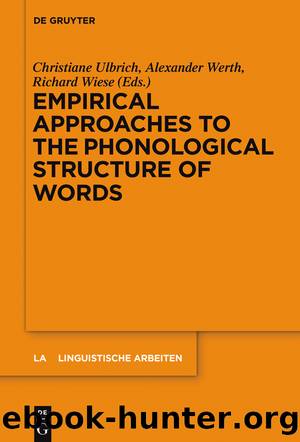Empirical Approaches to the Phonological Structure of Words by Christiane Ulbrich Alexander Werth Richard Wiese

Author:Christiane Ulbrich, Alexander Werth, Richard Wiese
Language: eng
Format: epub
Publisher: Walter de Gruyter
Published: 2018-04-15T00:00:00+00:00
3General discussion and conclusion
Overall, the three studies presented here clearly support the claim that the rhythmic-prosodic context affects morphophonological variation. The first study revealed an effect of the rhythmic pattern (due to the distribution of lexical stresses) on the realisation of the variable adverb gern(e) in oral reading. The second study, a forced choice experiment, showed that the variable morphosyntax of the possessive or partitive relation is susceptible to rhythmic structure. Finally, a corpus study demonstrates the non-independence of the prosodic shapes of variable adverbs in adverb-verb sequences.
As to the relative contribution of the three constraints under discussion (*CLASH, *LAPSE, PARALLELISM) for explaining the variance observed in the three experiments, the findings paint a somewhat mixed picture. The final corpus study quite clearly dismisses the importance of PARALLELISM, while showing that *LAPSE and *CLASH, have a clear impact on the choice of monosyllabic vs. trochaic adverb. Similarly, the experiment on the choice between morphological genitive and prepositional phrase reveals a weak effect of rhythmic alternation but fails to reveal an effect of prosodic parallelism.
The first experiment, however, suggests that prosodic parallelism has a role to play in the realisation of the variable adverb in oral reading. It shows that an iterating rhythm is effectively priming the morphophonological form of the variable adverb that continues the preceding (trochaic) rhythm. However, as highlighted in the discussion of that experiment, the iterating rhythm is only observable through the lens of certain assumptions regarding the foot structure involved, i.e. it is only valid when foot boundaries are allowed to straddle word boundaries (contra the Strict Layer Hypothesis) and when adverbs may be demoted to a prosodically weak position. That is, while there is clear evidence for the joint effects of *CLASH and *LAPSE conditioning the morphophonological structure of words and phrases, effects of prosodic parallelism are relatively minute. This is not to contest the relevance for prosodic parallelism in other contexts. As discussed in the introduction, prosodic parallelism is likely to be a constraining factor in word formation (e.g. reduplication) and it is clearly involved in poetic language. Quite possibly, the role of PARALLELISM is more pronounced in more artistic language use or, more generally in circumstances that are not as strictly constrained by time. Note that for PARALLELISM to become apparent, the linguistic processor needs to consider more material (at least two adjacent feet) than when evaluating local rhythmic well-formedness on a syllable-to-syllable basis.
All in all, the results of the studies presented suggest that phrases and sentences are not built by merely concatenating morphs according to a pre-specified syntactic structure. In addition, word forms may be altered in various ways to suit the supra-lexical rhythmic structure, and the rhythmic structure may reciprocally co-determine morphosyntactic choice.
Acknowledgements: I thank the organisers and the audience of the workshop on empirical approaches to the phonological structure of words (Marburg, October 2014) for the opportunity to present and discuss this work. Caroline Féry, Isabelle Franz, Ingo Plag, Renate Raffelsiefen and two anonymous reviewers provided helpful comments and constructive feedback on the manuscript.
Download
This site does not store any files on its server. We only index and link to content provided by other sites. Please contact the content providers to delete copyright contents if any and email us, we'll remove relevant links or contents immediately.
Whiskies (Collins Gem) by dominic roskrow(44972)
Spell It Out by David Crystal(36002)
Cecilia; Or, Memoirs of an Heiress — Volume 1 by Fanny Burney(32386)
Cecilia; Or, Memoirs of an Heiress — Volume 3 by Fanny Burney(31762)
Cecilia; Or, Memoirs of an Heiress — Volume 2 by Fanny Burney(31730)
Beautiful Disaster by McGuire Jamie(25211)
Trainspotting by Irvine Welsh(21464)
Chic & Unique Celebration Cakes by Zoe Clark(19902)
The Secret History by Donna Tartt(18775)
How High Can a Kangaroo Hop? by Jackie French(18745)
Twilight of the Idols With the Antichrist and Ecce Homo by Friedrich Nietzsche(18460)
All the Missing Girls by Megan Miranda(15426)
Cat's cradle by Kurt Vonnegut(15116)
Ready Player One by Cline Ernest(14457)
Fifty Shades Freed by E L James(13129)
For the Love of Europe by Rick Steves(12398)
4 3 2 1: A Novel by Paul Auster(12236)
Crooked Kingdom: Book 2 (Six of Crows) by Bardugo Leigh(12176)
Grundlagen Kreatives Schreiben (German Edition) by Helfferich Pia(10366)
